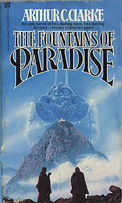
| Publisher: | Del Ray |
| Copyright: | 1978 |
| Printing: | February 1980 |
| ISBN: | 0-345-25356-6 |
| Format: | Mass market |
| Pages: | 305 |
This is the novel that first introduced the majority of SF readers to the concept of a space elevator. Briefly, the concept of a space elevator is that one can, in theory, given materials of sufficient strength, build a tower of sorts down from stationary orbit to a point on earth. Once complete, mass could be lifted into orbit and returned to earth from orbit at far less cost than traditional rocket boost, particularly since much of the energy spent sending something into orbit is regained by the return trip down to the surface.
This is the story of the building of the first space elevator, focusing on the engineer who builds it, and on a man who lives near the eventual building site in Sri Lanka, who lives in a slightly adapted version of Sigiriya. The history of Sigiriya (called Yakkagala in the book) is woven in as a background story in the first part of the book.
The core of this book is classic hard SF. There is a technical puzzle to overcome (the building of the elevator), a variety of both scientific and political puzzles in the way, and an incredibly competent main character. The characters are better fleshed out than in many books of this sort, but other than the main two characters, they're mostly still painted in broad strokes and serve primarily to provide background to the story rather than the other way around.
What Clarke does do unusually well, though, is weave into the story some of the impressive beauty and tradition of Sri Lanka (here called Taprobane and relocated a little to make it the perfect site for a space elevator). Much of the terrain, some of the history, and some of the religion is woven into the story, both as obstacles and as a beautiful sense of atmosphere. I came away with a much stronger sense of place than I often do from stories about scientific puzzles.
There is also, somewhat oddly, the story of First Contact interleaved with the story. I say somewhat oddly since this is purely world background, and only tangential background at that — I kept expecting it to become more directly relevant, and it never did. It was still one of the more interesting First Contact ideas that I've read, though, and had a decent conclusion of its own in the last chapter.
Recommended as an idea exploration, and also for the touches of Sri Lanka here.
Reviewed: 2004-08-02